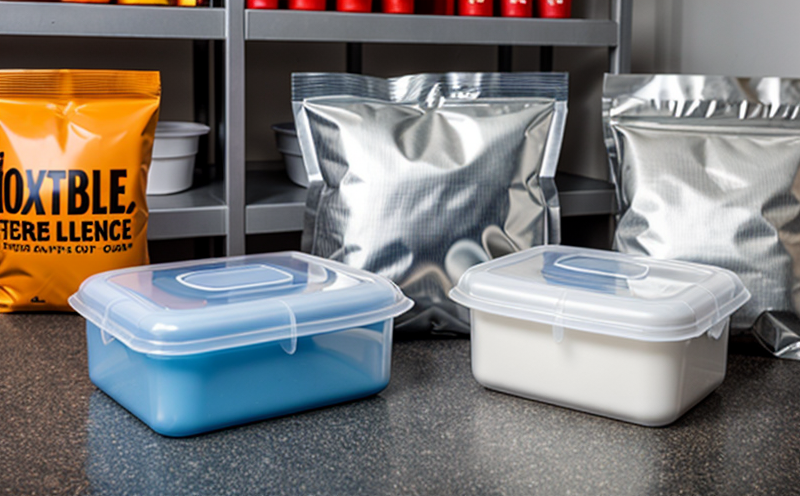ASTM F1249-13 Oxygen Transmission Testing
The ASTM F1249-13 standard test method is a critical procedure for the evaluation of oxygen transmission rates (OTR) through flexible packaging materials used in food and non-food industries. This testing ensures that packages maintain an optimal atmosphere, which is crucial to extend shelf life and preserve product quality.
OTR measures how much oxygen permeates across the material over a specific period under controlled conditions. Understanding OTR helps manufacturers design packages that balance gas barrier properties with other performance attributes like flexibility, printability, and mechanical strength.
The ASTM F1249-13 test is widely used in sectors such as food packaging to prevent spoilage from oxidation, pharmaceuticals where oxygen can degrade active ingredients, and electronics packaging where gases may affect the performance of sensitive components. Compliance with this standard ensures that products meet industry quality standards and regulatory requirements.
The testing process involves placing a known weight or volume of a material sample in an oxygen-controlled container. The container is then sealed and equilibrated to a specific oxygen concentration, after which it is stored under controlled conditions for a predetermined time period. During this time, the amount of oxygen that permeates through the test specimen is measured.
The results are expressed as OTR in units such as milliliters per square meter per day (ml/m²/day) or cubic centimeters per square meter per day (cm³/m²/day). These values provide crucial insights into the barrier properties of packaging materials and help guide material selection and design.
For accurate testing, it is essential to follow ASTM F1249-13 precisely. This includes selecting appropriate test specimens that accurately represent the actual packaging in use, maintaining consistent environmental conditions during testing, and using calibrated equipment for precise measurement of oxygen content.
The importance of this test cannot be overstated, especially in industries where product quality is directly linked to proper packaging design. By ensuring OTR compliance, companies can enhance the performance and longevity of their products while meeting regulatory requirements and market expectations.
Customer Impact and Satisfaction
The ASTM F1249-13 oxygen transmission testing plays a pivotal role in enhancing customer satisfaction by ensuring that the products they purchase are of high quality. By meeting the required OTR values, companies can guarantee that their packaging effectively preserves product integrity and freshness.
For businesses operating in global markets, compliance with this standard is crucial as it ensures that products meet international quality standards and regulatory requirements. This not only facilitates easier market entry but also enhances customer trust and brand loyalty.
The test results are particularly beneficial for quality managers and R&D engineers who rely on accurate data to make informed decisions about material selection, packaging design, and production processes. By leveraging ASTM F1249-13, these professionals can ensure that their products meet the highest standards of quality and reliability.
Moreover, this test helps in reducing waste by optimizing packaging materials, thereby minimizing unnecessary resource consumption and environmental impact. This aligns with modern corporate sustainability goals and contributes to a more eco-friendly supply chain.
Use Cases and Application Examples
The ASTM F1249-13 oxygen transmission test is applicable in various industries, including food packaging, pharmaceuticals, electronics, and cosmetics. Here are a few specific use cases:
- Food Packaging: Ensuring that the package prevents oxidation of fats and oils to maintain product freshness.
- Pharmaceuticals: Protecting sensitive drugs from degradation by oxygen, thereby maintaining their efficacy.
- Electronics: Shielding components from moisture and gases that could affect performance or lifespan.
- Cosmetics: Preventing the oxidation of active ingredients in skincare products to ensure product quality.
In each case, the test helps manufacturers design packages that not only meet regulatory requirements but also enhance product longevity and performance. This is particularly important for companies operating internationally, as it ensures compliance with global standards.
Why Choose This Test
- Promotes Quality Control: Ensures that packaging materials meet the required OTR values, leading to better product quality and consumer satisfaction.
- Meets Regulatory Requirements: Compliance with ASTM F1249-13 helps companies avoid legal issues and ensures they can confidently market their products domestically and internationally.
- Improves Product Shelf Life: By controlling the amount of oxygen that penetrates into the package, this test extends the shelf life of food, pharmaceuticals, and other sensitive products.
- Aids in Material Selection: Helps manufacturers choose materials with appropriate OTR values to balance cost, flexibility, and barrier properties.
- Enhances Brand Reputation: Consistent quality control through this test can enhance a brand’s reputation for reliability and excellence.





